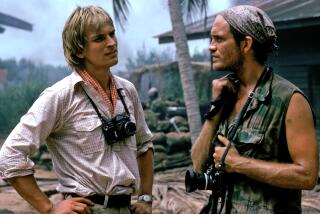Paul Landres, 89; Film Editor Later Directed B Movies and TV Series
- Share via
Paul Landres, an early sound-era film editor who turned to directing B pictures in 1949 and became a prolific director of early television series, has died. He was 89.
Landres, who began his motion picture career as an assistant editor in 1931, died of complications from cancer Wednesday at his home in Encino.
As a director of low-budget feature films in the 1950s and early ‘60s, Landres racked up credits including the rock ‘n’ roller “Go, Johnny, Go!” starring Chuck Berry, Eddie Cochran and Ritchie Valens, and two cult horror favorites, “The Return of Dracula” and “The Vampire.”
“They were two of the best independent horror pictures of the ‘50s,” said Tom Weaver, a horror and science fiction expert who interviewed Landres for Fangoria magazine.
Landres directed only a couple dozen feature films; he did most of his work in television, directing about 350 episodes of series including “Adam 12,” “Blondie,” “Bonanza,” “The Cisco Kid,” “Daktari,” “Daniel Boone,” “Death Valley Days,” “Hawaiian Eye,” “The Life and Legend of Wyatt Earp,” “The Lone Ranger,” “Maverick,” “Ramar of the Jungle,” “The Rifleman,” “77 Sunset Strip,” “Sky King,” “Surfside Six” and “Topper.”
Born in New York City in 1912, Landres moved with his family to Los Angeles when he was an infant. He attended UCLA for two years but dropped out to enter the film business in 1931 as an assistant editor at Universal Studios.
“He needed a job, and the business needed people, so he kind of just fell into it,” said his son Richard of La Jolla.
By 1937, Landres had been promoted to editor at Universal, where he edited B movies, including one of the better Sherlock Holmes films, “The Scarlet Claw,” starring Basil Rathbone. Landres’ biggest credit as an editor was “Pittsburgh,” a 1942 drama starring John Wayne and Marlene Dietrich.
Landres left Universal in the late ‘40s and, after freelancing briefly as an editor, began directing for a small B movie studio. His first credit as a director was the low-budget “Grand Canyon,” starring Richard Arlen, in 1949.
Makes Switch to Television
But responding to the new opportunities in television, Landres began making the switch to the medium in 1950, working first for pioneer syndicator Frederick W. Ziv, for whom he directed “Boston Blackie” and “The Cisco Kid.” Landres later worked extensively on TV series produced at Warner Bros.
As a director, he brought his years as a film editor to bear both in film and television, said Francis M. Nevins, author of “Paul Landres: A Director’s Stories.”
“Paul had a unique way of directing,” Nevins said. “What he did when he got a script is he’d take it home and read it and think about it and visualize what he wanted to do. Then he’d begin drawing what he called schematic drawings.”
They were diagrams of the sets, drawn with different colored pencils, showing camera positions and movements, as well the actors’ movements and the location of key props.
“He’d have 40 or 50 of these by the time he was ready to shoot the picture,” Nevins said. “He developed this method early on in his career, and he talked constantly about how well the experience he had editing pictures served him as a director. You can actually see that if you watch his films. He shot for the cutting room.”
Nevins said Landres had his diagrams bound with his scripts, which he donated to USC several years ago.
Landres, who retired in the early 1970s, was a founding member of American Cinema Editors, the honorary film editors society established in 1950.
In addition to his son Richard, Landres is survived by his wife of 60 years, Jean; two other sons, Bruce of West Los Angeles and Jeffrey of Thousand Oaks; a daughter, Lisa of Venice; his brother, Howard of Beverly Hills; and six grandchildren.
More to Read
Only good movies
Get the Indie Focus newsletter, Mark Olsen's weekly guide to the world of cinema.
You may occasionally receive promotional content from the Los Angeles Times.










